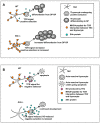Hedgehog Signalling in the Embryonic Mouse Thymus
- PMID: 27504268
- PMCID: PMC4975939
- DOI: 10.3390/jdb4030022
Hedgehog Signalling in the Embryonic Mouse Thymus
Abstract
T cells develop in the thymus, which provides an essential environment for T cell fate specification, and for the differentiation of multipotent progenitor cells into major histocompatibility complex (MHC)-restricted, non-autoreactive T cells. Here we review the role of the Hedgehog signalling pathway in T cell development, thymic epithelial cell (TEC) development, and thymocyte-TEC cross-talk in the embryonic mouse thymus during the last week of gestation.
Keywords: Gli1; Gli2; Gli3; Hedgehog; Ihh; Shh; T cell development; thymic epithelial cell (TEC); thymus.
Conflict of interest statement
The authors declare no conflict of interest.
Figures





References
Grants and funding
LinkOut - more resources
Full Text Sources
Other Literature Sources
Molecular Biology Databases
Research Materials
